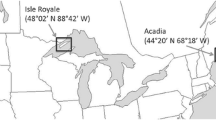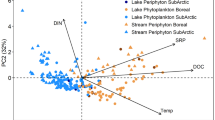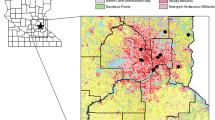Abstract
Nutrient limitation commonly constrains organisms in natural ecosystems. Typically, ecologists focus on limitation by N and P. However, other nutrients can limit growth or reproduction. Here we focus on K limitation of invertebrate consumers (Daphnia dentifera) and phytoplankton in freshwater lakes. All organisms require K for several metabolic processes. In freshwater, K could limit growth because low external concentrations can increase the energetic costs of accumulating K. Furthermore, in a study linking K to disease, we previously found that K enrichment of water from one low-K lake stimulated the growth and reproduction of Daphnia. Here we test whether K could limit the production of Daphnia and phytoplankton across lakes and years. We repeated a life table experiment using water collected from a low-K lake during a different year. K again stimulated Daphnia reproduction. We also enriched water from 12 lakes with K or P and measured short-term growth of Daphnia and the resident algal community. Both nutrients increased Daphnia growth in five lakes. However, only P enhanced algal production. P stimulation of Daphnia positively correlated with algal quantity and the ratio of C to P in seston. However, K stimulation of Daphnia was not correlated with these factors or the background concentration of K. Thus, this study shows repeatable K-limited animal physiology in nature. Further, we can exclude the hypothesis that K stimulates Daphnia indirectly by enhancing algal production. These patterns call for future physiological studies to uncover the mechanistic basis of K limitation in natural systems.




Similar content being viewed by others
References
Ahlgren G, Goedkoop W, Markensten H, Sonesten L, Boberg M (1997) Seasonal variations in food quality for pelagic and benthic invertebrates in Lake Erken—the role of fatty acids. Freshwater Biol 38:555–570
Boersma M, Kreutzer C (2002) Life at the edge: is food quality really of minor importance at low quantities? Ecology 83:2552–2561
Canfield DE, Glazer AN, Falkowski PG (2010) The evolution and future of Earth’s nitrogen cycle. Science 330:192–196
Civitello DJ, Forys P, Johnson AP, Hall SR (2012) Chronic contamination decreases disease spread: a Daphnia-fungus-copper case study. Proc R Soc B 279:3146–3153
Civitello DJ, Pencyzkowski RM, Hite JL, Duffy MA, Hall SR (2013) Potassium stimulates fungal epidemics in Daphnia by increasing host and parasite reproduction. Ecology 94:380–388
Coale KH, Johnson KS, Fitzwater SE, Gordon RM, Tanner S, Chavez FP, Ferioli L, Sakamoto C, Rogers P, Millero F, Steinber P, Nightingale P, Cooper D, Cochlan WP, Landry MR, Costantinou J, Rollwagen G, Trasvina A, Kudela R (1996) A massive phytoplankton bloom induced by an ecosystem-scale iron fertilization experiment in the equatorial Pacific Ocean. Nature 383:495–501
Crumpton WG, Isenhard TM, Mitchell PD (1992) Nitrate and organic N analyses with second-derivative spectroscopy. Limnol Oceanogr 37:907–913
DeMott WR, Tessier AJ (2002) Stoichiometric constraints vs. algal defenses: testing mechanisms of zooplankton food limitation. Ecology 83:3426–3433
DeMott WR, Van Donk E (2013) Strong interactions between stoichiometric constraints and algal defenses: evidence from population dynamics of Daphnia and algae in phosphorus-limited microcosms. Oecologia 171:175–186
Dixon PM (1993) The bootstrap & the jackknife: describing the precision of ecological indices. In: Scheiner SM, Gurevitch J (eds). Design and analysis of ecological experiments. Oxford University Press, pp 267–288
Donini A, Patrick ML, Bijelic G, Christensen RJ, Ianowski JP, Rheault MR, O’Donnell MJ (2006) Secretion of water and ions by malpighian tubules of larval mosquitoes: effects of diuretic factors, second messengers, and salinity. Physiol Biochem Zool 79:645–655
Downing JA, Osenberg CW, Sarnelle O (1999) Meta-analysis of marine nutrient-enrichment experiments: variation in the magnitude of nutrient limitation. Ecology 80:1157–1167
Duffy MA, Ochs JH, Penczykowski RM, Civitello DJ, Klausmeier CA, Hall SR (2012) Ecological context influences epidemic size and parasite-driven evolution. Science 335:1636–1638
Elser JJ, Fagan WF, Denno RF, Dobberfuhl DR, Folarin A, Huberty A, Interlandi S, Kilham S, McCauley E, Schulz KL, Siemann EH, Sterner RW (2000) Nutritional constraints in terrestrial and freshwater food webs. Nature 408:578–580
Elser JJ, Hayakawa K, Urabe J (2001) Nutrient limitation reduces food quality for zooplankton: Daphnia response to seston phosphorus enrichment. Ecology 82:898–903
Elser JJ, Bracken ME, Cleland EE, Gruner DS, Harpole WS, Hillebrand H, Ngai JT, Seabloom EW, Shurin JB, Smith JE (2007) Global analysis of nitrogen and phosphorus limitation of primary producers in freshwater, marine and terrestrial ecosystems. Ecol Lett 10:1135–1142
Elser JJ, Kyle M, Steger L, Nydick KR, Baron J (2009) Nutrient availability and phytoplankton nutrient limitation across a gradient of atmospheric nitrogen deposition. Ecology 90:3062–3073
Frost PC, Ebert D, Smith VH (2008) Responses of a bacterial pathogen to phosphorus limitation of its aquatic invertebrate host. Ecology 89:313–318
Gerloff GC, Fishbeck KA (1969) Quantitative cation requirements of several green and blue-green algae. J Phycol 5:109–114
Gotelli NJ, Ellison AM (2004) A primer of ecological statistics. Sinauer, Sunderland
Hall SR (2009) Stoichiometrically explicit food webs: feedbacks between resource supply, elemental constraints, and species diversity. Annu Rev Ecol Evol Syst 40:503–528
Hall SR, Simons JL, Nisbet RM, Tessier AJ, Cáceres CE (2009) Resource ecology of virulence in a planktonic host–parasite system: an explanation using dynamic energy budgets. Am Nat 174:149–162
Jenner GA, Longerich HP, Jackson SE, Fryer BJ (1990) ICP-MS—a powerful tool for high-precision trace element analysis in the earth sciences: evidence from analysis of selected USGS reference samples. Chem Geol 83:133–148
Jeziorski A, Yan ND, Paterson AM, DeSellas AM, Turner MA, Jeffries DS, Keller B, Weeber RC, McNicol DK, Palmer ME, McIver K, Arseneau K, Ginn BK, Cumming BF, Smol JP (2008) The widespread threat of calcium decline in fresh waters. Science 322:1374–1377
Lampert W, Trubetskova I (1996) Juvenile growth rate as a measure of fitness in Daphnia. Funct Ecol 10:631–635
Legendre P, Legendre L (1998) Numerical ecology. Elsevier, Amsterdam
Marschner H (1995) Mineral nutrition of higher plants. Academic Press, London
Martin-Creuzburg D, Sperfeld E, Wacker A (2009) Colimitation of a freshwater herbivore by sterols and polyunsaturated fatty acids. Proc R Soc B 276:1805–1814
McCallum H (2000) Population parameters: estimation for ecological models. Wiley-Blackwell, New York
Muller-Navarra DC, Brett MT, Park S, Chandra S, Ballantyne AP, Zorita E, Goldman CR (2004) Unsaturated fatty acid content in seston and tropho-dynamic coupling in lakes. Nature 427:69–72
Oren R, Ellsworth DS, Johnsen KH, Phillips N, Ewers BE, Maier C, Schafer KV, McCarthy H, Hendrey G, McNulty SG, Katul GG (2001) Soil fertility limits carbon sequestration by forest ecosystems in a CO2-enriched atmosphere. Nature 411:469–472
Prepas EE, Rigler FH (1982) Improvements in quantifying the phosphorus concentration in lake water. Can J Fish Aquat Sci 39:822–829
Schindler DW (2012) The dilemma of controlling cultural eutrophication of lakes. Proc R Soc B 279:4322–4333
Sokal RR, Rohlf FJ (1995) Biometry, 3rd edn. Freeman, New York
Sterner RW (1997) Modelling interactions of food quality and quantity in homeostatic consumers. Freshwater Biol 38:473–481
Sterner RW, Elser JJ (2002) Ecological stoichiometry: the biology of elements from molecules to the biosphere. Princeton University Press, New York
Sterner RW, Hessen DO (1994) Algal nutrient limitation and the nutrition of aquatic herbivores. Annu Rev Ecol Syst 25:1–29
Talling JF (2010) Potassium—a non-limiting nutrient in fresh waters? Freshwater Rev 3:97–104
VanDonk E, Lurling M, Hessen DO, Lokhorst GM (1997) Altered cell wall morphology in nutrient-deficient phytoplankton and its impact on grazers. Limnol Oceanogr 42:357–364
Webb DJ, Burnison BK, Trimbee AM, Preprass EE (1992) Comparison of chlorophyll a extractions with ethanol and dimethyl-sulfoxide acetone, and a concern about spectrophotometric pheopigment correction. Can J Fish Aquat Sci 49:2331–2336
Welschmeyer NA (1994) Fluorometric analysis of chlorophyll-a in the presence of chlorophyll-b and pheopigments. Limnol Oceanogr 39:1985–1992
Williams RJP (1970) Tilden lecture. The biochemistry of sodium, potassium, magnesium, and calcium. Q Rev Chem Soc 24:331–365
Acknowledgments
D. J. C. and J. L. H. performed the nutrient enrichment assays with A. Peters and J. Watson through the Lilly Scholars Program (LSP) at Indiana University. We thank M. Tellas (LSP program director) and the Lilly Endowment for funding the LSP. K. Boatman, Z. Brown, L. Davies, and J. Lawitschka also helped with experiments. We thank R. Penczykowski (Duffy Lab, Georgia Institute of Technology) and S. Brovold (Sterner Lab, University of Minnesota) for analyzing seston P and C, respectively. This work was supported by the National Science Foundation (0841679, 0841817). D. J. C. was supported by a STAR fellowship from the USA Environmental Protection Agency. We appreciate cooperation from S. Siscoe at the Indiana Department of Natural Resources Division of Forestry and R. Ronk at the Division of Fish and Wildlife. D. J. C. and S. R. H. designed the experiments; D. J. C. and J. L. H. performed the experiments; D. J. C. analyzed the data and wrote the first draft; all authors edited the manuscript.
Author information
Authors and Affiliations
Corresponding author
Additional information
Communicated by Ken Spitze.
Electronic supplementary material
Below is the link to the electronic supplementary material.
Rights and permissions
About this article
Cite this article
Civitello, D.J., Hite, J.L. & Hall, S.R. Potassium enrichment stimulates the growth and reproduction of a clone of Daphnia dentifera . Oecologia 175, 773–780 (2014). https://doi.org/10.1007/s00442-014-2943-5
Received:
Accepted:
Published:
Issue Date:
DOI: https://doi.org/10.1007/s00442-014-2943-5




